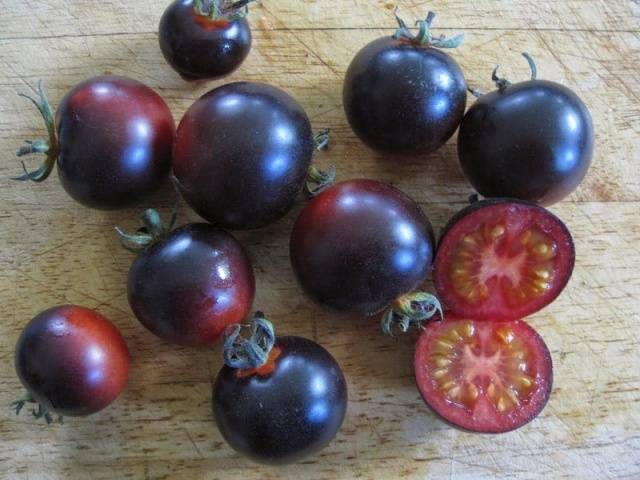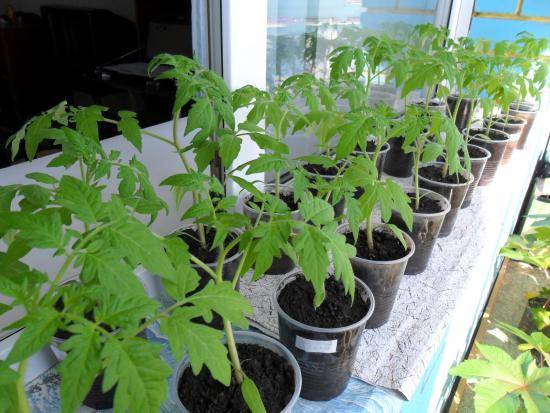Content
Among the wide variety of tomatoes, the gardener chooses those that suit him best. Everyone has their own selection criteria. For some, the main thing is productivity, for others the taste of the fruit comes first. There is a large group of people who like to grow exotic varieties. They offer not only a large assortment of seeds sold by various companies, but also collections of passionate tomato growers who are not averse to sharing seeds of rare varieties.
Where do dark tomatoes come from?
Many gardeners believe that black tomatoes are the fruit of genetic engineering and are a transgenic product. This is actually not true. Indeed, in nature, plants have practically no gene responsible for the black color of fruits. But there are 6 other genes that form the color of tomatoes. Acting together, they produce substances that determine their color:
- chlorophyll – present in any green fruit;
- lycopene - it is what gives tomatoes their red color;
- carotenoids, most of them in carrots and pumpkin, but also in tomatoes;
- anthocyanins - give the corresponding color to beets and other purple-colored vegetables. It is they, together with the rest, that give tomatoes their original dark color.
Benefits of dark-colored tomatoes
The red tomatoes familiar to most people are being replaced by varieties colored “not according to the rules.” Among them are brown, blue and even black. How are they better than traditionally colored tomatoes? The color of a tomato is due to the content of coloring pigments that have many beneficial properties. While all varieties contain beneficial lycopene and carotenoids, only black and purple tomatoes can boast of anthocyanin content.
Why are anthocyanins valuable?
- are immunostimulants;
- have bactericidal properties;
- strengthen the walls of blood vessels, especially capillaries;
- have an anti-edematous effect;
- are antioxidants, i.e. they are able to bind free radicals, helping to avoid cancer.
They are not synthesized in the human body, but they are very necessary for it, especially during illness. That is why products that help eliminate the deficiency of this essential substance are so valuable.
There are not many truly black tomatoes. The darkest of them is deservedly considered the Indigo Rose variety. It shares the palm with another original tomato, which is called Blueberry.
To understand what the Indigo Rose tomato variety is, we will compose a detailed description and description of this curiosity, but for now let’s admire the photo.
Characteristics and description
The Indigo Rose tomato variety was developed quite recently.In 2015, American University of Oregon horticulture professor Jim Myers crossed purple-colored cultivated varieties with representatives of wild tomato flora native to the Galapagos Islands and Chile. The result was an amazing black-colored variety.
Its features:
- The ripening period is early, the first fruits can be tasted after 100 days, and in hot summers even a little earlier;
- the Indigo Rose tomato variety can be grown in open ground, where it grows up to 1 m, and in a greenhouse, where its height is somewhat greater; according to gardeners, it can grow up to one and a half meters;
- The bush is not very leafy, the leaves are of the usual type. Sometimes they can curl - this is a feature of the variety;
- Tomato variety Indigo Rose forms a simple cluster, the number of fruits in it is from 6 to 8;
- the color of the skin is black, but not always: if the fruit is covered with leaves from the sun, part of it remains pink - hence its name;
- the skin is quite dense, which makes it possible to use Indigo rose tomatoes not only in salads, but also in marinades and pickles;
- tomatoes of this variety store well, their taste is interesting, very rich, the inside of the fruit is red;
- Indigo rose tomatoes have a very strong aroma that can be felt several meters away;
- the size of the fruits strongly depends on the care, most manufacturers position it as a cocktail variety, but reviews from gardeners say that the fruits can be larger - up to 100 g;
- The originator of the variety claims that the plants of this tomato can withstand frosts down to -5 degrees, but reviews from gardeners on this matter are mixed.
To give a complete description and description of the Indigo Rose tomato variety, it must be said that it is characterized by increased resistance to late blight.
Until recently, Indigo Rose tomato seeds could only be found among collectors. Now they are distributed by Biotechnika.
The yield of this variety is average, but it is valued not for that, but for the excellent dessert taste of the fruit.
Agricultural technology of black-fruited tomatoes
Breeders are still debating whether the acquisition of such an unusual color benefited the plants. Among some of them there is an opinion about the low germination of seeds of this variety, slow growth, long ripening period and poor resistance to diseases, although reviews from gardeners often say the opposite.
But first you have to grow seedlings.
Growing seedlings
Growing seedlings of these tomatoes has no special features.
- We prepare the seeds: we treat them with a disinfectant - potassium permanganate at a concentration of 1% or a solution of phytosporin. In order not to worry about seedlings, it is best to germinate the seeds of the Indigo Rose variety of tomatoes. We do this after soaking in a growth stimulator, which we carry out according to the instructions for the selected drug.
- Germination is best done in damp cotton pads.
For successful germination, greenhouse conditions are needed: constant high temperature and high humidity. - We sow the sprouted seeds into the soil for tomatoes and keep them warm until germination, not allowing the soil to dry out. To prevent plants from wasting time adapting after picking, it is better to plant them immediately in separate cups.
- Hatching loops are a signal that the seedlings need light. We move them to the brightest place so that the seedlings do not stretch out.
- We keep the seedlings at a temperature of 18 degrees at night and about 22 degrees during the day.
- Watering is needed infrequently, but sufficiently so that the soil in the pot is completely wet.
- For better growth, we feed the sprouts 2 times with a weak solution of mineral fertilizers: in the phase of 2-3 true leaves and after another 2 weeks.
Care after disembarkation
The planting pattern for this variety is usual: 40-50x60 cm. Further care is as follows.
- Watering. The Indigo rose tomato is considered a drought-resistant variety, so watering it once a week with warm water is quite enough. But this is subject to mulching the soil with organic materials.
- Feeding. They are standard: the first one is planted 2 weeks after the seedlings take root, the subsequent ones - once every ten days. They use complete mineral fertilizer, adding ash to it during the fruiting period as a source of potassium. No blossom end rot disease was observed on tomatoes of this variety, but on sandy loam and sandy soils it is better to apply a single fertilizing with calcium nitrate at the moment of ovary formation on the second cluster. Spraying with a solution of boric acid at the time of flowering of tomatoes will help increase the yield. They are carried out 2 times.
- Formation. Both in the open ground and in the greenhouse, the Indigo Rose tomato variety needs pinching and staking. In the south, you can remove the stepsons up to the first cluster; to the north, the tomato is formed into 2 stems, removing all the other stepsons.
A few words about harvesting.Indigo rose tomatoes become fully ripe when they have acquired the characteristic color of this variety and become slightly soft. Many gardeners pick tomatoes before they are fully ripe and are disappointed with the taste.
Here's how to grow tomatoes of this variety without pinching:
If you want not only to eat a delicious vegetable, but also to be treated with it, the Indigo Rose tomato variety is the best choice.



















